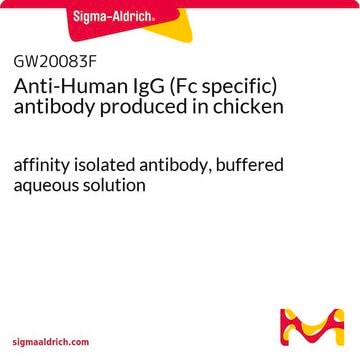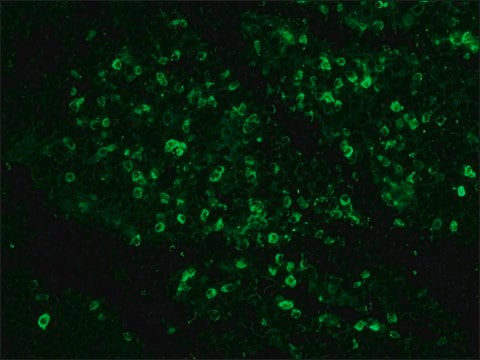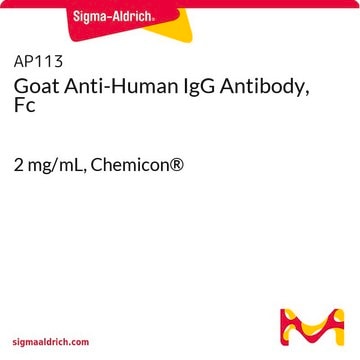I2136
Anti-Human IgG (Fc specific) antibody produced in goat
affinity isolated antibody, buffered aqueous solution
Synonyme(s) :
Anti Human IgG Fc - Anti-Human IgG (Fc specific) antibody produced in goat, Anti Human Igg, Anti Human Igg Antibody, Anti-Human Igg, Anti-Human Igg Fc, Goat Anti Human Igg
About This Item
Produits recommandés
Source biologique
goat
Conjugué
unconjugated
Forme d'anticorps
affinity isolated antibody
Type de produit anticorps
secondary antibodies
Clone
polyclonal
Forme
buffered aqueous solution
Technique(s)
indirect ELISA: 1:10,000
Conditions d'expédition
dry ice
Température de stockage
−20°C
Modification post-traductionnelle de la cible
unmodified
Vous recherchez des produits similaires ? Visite Guide de comparaison des produits
Description générale
Immunoglobulins comprise of two fragment antigen binding (Fab) and one fragment crystallizable (Fc) domains. The gene encoding IgG gene cluster is located on human chromosome 14.
Anti-Human IgG (Fc specific) antiserum is produced in goat using purified human IgG, Fc fragment, as the immunogen. Affinity isolated antibody is obtained from goat anti-human IgG antiserum by immunospecific purification which removes essentially all goat serum proteins, including immunoglobulins, which do not specifically bind to the Fc fragment of human IgG.
Spécificité
Immunogène
Application
- in double-capture ELISA to measure antiglobulin responses in serum of transplant patients treated with CD52 monoclonal antibodies (CAMPATH-1G)
- in detection of IgG levels rheumatoid arthritis patients
- in small intestine biopsies
- in patients with acute myocardial infarction by immunoblotting
Enzyme-linked immunosorbent assay (1 paper)
Actions biochimiques/physiologiques
Forme physique
Stockage et stabilité
Clause de non-responsabilité
Not finding the right product?
Try our Outil de sélection de produits.
Code de la classe de stockage
12 - Non Combustible Liquids
Classe de danger pour l'eau (WGK)
WGK 3
Point d'éclair (°F)
Not applicable
Point d'éclair (°C)
Not applicable
Équipement de protection individuelle
Eyeshields, Gloves, multi-purpose combination respirator cartridge (US)
Certificats d'analyse (COA)
Recherchez un Certificats d'analyse (COA) en saisissant le numéro de lot du produit. Les numéros de lot figurent sur l'étiquette du produit après les mots "Lot" ou "Batch".
Déjà en possession de ce produit ?
Retrouvez la documentation relative aux produits que vous avez récemment achetés dans la Bibliothèque de documents.
Les clients ont également consulté
Articles
Review the key factors that should figure in your decision to choose a secondary antibody. Learn about species, subclass, isotype, label, and more.
Notre équipe de scientifiques dispose d'une expérience dans tous les secteurs de la recherche, notamment en sciences de la vie, science des matériaux, synthèse chimique, chromatographie, analyse et dans de nombreux autres domaines..
Contacter notre Service technique

















